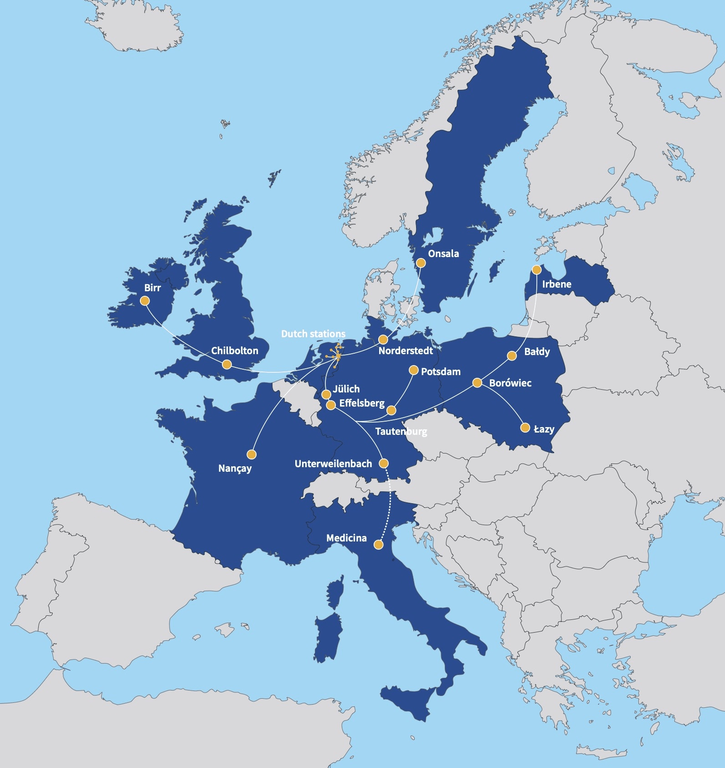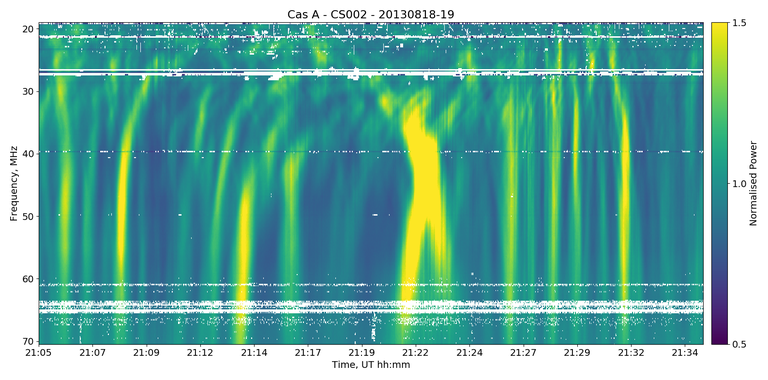Low-frequency radio telescope
The Low-Frequency Array (LOFAR) is a network that consists of a large number (approx. 6,300) of highly-sensitive receivers operating across a frequency range of 10-250 MHz, installed at 52 stations scattered across much of western Europe (Figure 1). It was designed primarily as an astronomical radio telescope, but the extra-terrestrial signals it receives are strongly affected by their passage through the ionosphere, which means that LOFAR can be used as an ionospheric observatory in its own right.

Figure 1: Map showing the locations of LOFAR stations across western Europe.
The low-frequency radio telescope can be used to observe ionospheric scintillation.
Radio waves from compact sources (such as satellites or celestial bodies) can be strongly affected by the ionosphere. Diffraction of the wavefront by small-scale density structures in the ionosphere leads to variations in the intensity of the received wave an effect known as scintillation. Strong ionospheric scintillation can disrupt satellite signals and hence is one of the main “risk factors” in our increasing reliance on such technology in everyday life.
Observations of scintillation thus contain a great deal of information on the ionosphere, including the large-scale density, turbulence, and the movement of the medium across the line of sight. LOFAR can record wide-bandwidth dynamic spectra of ionospheric scintillation (Figure 2) across the VHF band with high time and frequency resolutions, complementing measurements taken at much higher frequencies using GNSS receiver networks. The additional information in such data is essential to fully understand and model the scintillation and conditions giving rise to it, and inform efforts to predict its occurrence and severity.

Figure 2: Intensity ionospheric scintillation observed by one LOFAR station in August 2013.
The low-frequency radio telescope can also be used for ionospheric electron content mapping.
High-resolution images of all the extra-terrestrial radio sources in the sky produced by astronomers are the result of careful calibration of the received signals for the effects of the ionosphere. This means that the calibration parameters generated in this process can provide detailed information on large-scale density structure in the ionosphere, such as variations in the Total Electron Content (TEC) to complement and expand upon information available from GNSS receiver networks.
The low-frequency radio telescope can also be used to measure ionospheric opacity.
Geomagnetic activity and solar X-ray flares can result in strong absorption of low-frequency radio waves (below approximately 50 MHz) due to increased ionization in the lower-altitude D-region of the ionosphere. This absorption can be measured with a Relative Ionospheric Opacity meter or RIOmeter. All LOFAR stations are equipped with their own correlator which can produce low-resolution all-sky images once a second for any frequency in the range 10 - 80 MHz. A two-week running average of these images can be subtracted from each individual one to reveal absorption across the entire sky. The result is similar to that of the RIOmeter, except that absorption sky maps are produced instead of a single absorption figure.
The low-frequency radio telescope can also be used as a passive radar.
The LOFAR stations can be used as passive radar receivers, receiving radio waves scattered by the ionosphere from terrestrial transmitters. Experiments to date have detected strong reflections from regions of sporadic-E of over-the-horizon transmitters corresponding to the directions of major cities across Europe.
